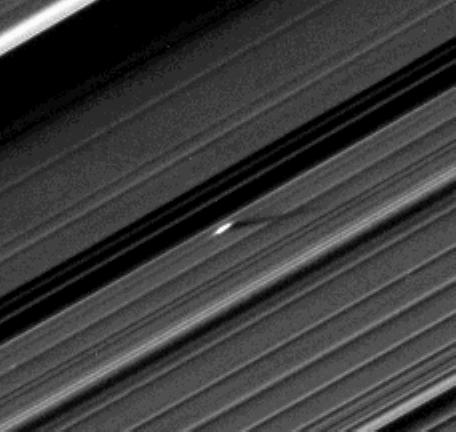NASA dixit:
“August 13, 2009. An unusually large propeller feature is detected just beyond the Encke Gap in this Cassini image of Saturn’s outer A ring taken a couple days after the planet’s August 2009 equinox.
The unique geometry of equinox has thrown into relief small moonlets within the rings and the structures they create around them. Propeller-like features, a few kilometers long, centered on and created by the action of small embedded moonlets only about 100 meters across, were discovered early in the mission. These previous findings constituted the first recognition of the presence in Saturn’s rings of bodies bigger than the largest ring particles (about 10 meters, or 30 feet, across) but smaller than the 8-kilometer-wide (5-mile-wide) ring moon, Daphnis, in the outer A ring.
From the 350-kilometer (220-mile) length of the shadow cast by this 130-kilometer-long (80-mile-long) propeller, the heights of these features above the ring plane have been measured to reach about 200 meters (650 feet), indicating the moonlet responsible for the propeller in this image is likely to be 400 meters (1,300 feet) across.
Cassini scientists have tracked several individual propeller moons embedded in Saturn’s A ring over several years. The A ring is the outermost of Saturn’s main rings. Imaging scientists nicknamed the propeller shown here “Earhart” after the American aviatrix Amelia Earhart.
It has since become a growing realization resulting from Cassini’s exploration of Saturn that the objects forming Saturn’s rings very likely span the full spectrum of sizes, from the smallest dust-sized ring particles to the ring-moons like Daphnis and 29-kilometer-wide (18-mile-wide) Pan — a significant advance in divining the origin of Saturn’s rings.
The novel illumination geometry that accompanies equinox lowers the sun’s angle to the ring plane, significantly darkens the rings, and causes out-of-plane structures to cast long shadows across the rings. (The rings have been brightened in this image to enhance visibility.) These scenes are possible only during the few months before and after Saturn’s equinox which occurs only once in about 15 Earth years.
This view looks toward the northern side of the rings from about 20 degrees above the ring plane. The image was taken in visible light with the Cassini spacecraft narrow-angle camera. The view was acquired at a distance of approximately 1.2 million kilometers (746,000 miles) from Saturn and at a sun-Saturn-spacecraft, or phase, angle of 87 degrees. Image scale is 7 kilometers (4 miles) per pixel.”
“After almost 20 years in space, NASA’s Cassini spacecraft begins the final chapter of its remarkable story of exploration: its Grand Finale. Between April and September 2017, Cassini will undertake a daring set of orbits that is, in many ways, like a whole new mission. Following a final close flyby of Saturn’s moon Titan, Cassini will leap over the planet’s icy rings and begin a series of 22 weekly dives between the planet and the rings.
No other mission has ever explored this unique region. What we learn from these final orbits will help to improve our understanding of how giant planets – and planetary systems everywhere – form and evolve.
On the final orbit, Cassini will plunge into Saturn’s atmosphere, sending back new and unique science to the very end. After losing contact with Earth, the spacecraft will burn up like a meteor, becoming part of the planet itself.
Cassini’s Grand Finale is about so much more than the spacecraft’s final dive into Saturn. That dramatic event is the capstone of six months of daring exploration and scientific discovery. And those six months are the thrilling final chapter in a historic 20-year journey.”
Image credit: NASA













 Subscribe to our RSS feed
Subscribe to our RSS feed












There are no comments.
Add A Comment